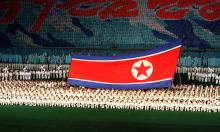Russian space apparel designers
When it comes to the outfit of an astronaut or cosmonaut, most people imagine a spacesuit like the ones astronauts and cosmonauts normally wear in official photographs.
At the beginning of space exploration, the "trailblazers of the universe" usually wore spacesuits from take-off until landing on short flights. However, once long space flights began, spacesuits were only worn during the launch, docking, undocking and landing. Today Sokol spacesuits are worn for operations inside a spaceship and Orlan spacesuits are worn during spacewalks. The rest of the time during missions at the Mir station and now the International Space Station, astronauts and cosmonauts wear ordinary clothes.
Kentavr-Nauka, a Russian company, has been making space clothing for over two decades. American astronauts are offered standard clothes made by several different companies. Their clothes primarily come in different shades of blue. Consequently, many U.S. astronauts prefer to order their space apparel from Russia, although they do not talk about this much for "diplomatic" reasons.
Michael Foale, an American astronaut currently on the ISS, ordered all his underwear and clothes from Kentavr-Nauka. "I was on a long mission at the Mir space station and I want to have that underwear," said Foale commenting on his choice.
The process of making clothing for space begins at the moment it becomes known who the next person to go into space will be. A designer goes to Zvyozdny (Star City) to take measurements of the cosmonauts and astronauts. While underwear is made according to standard measurements, the rest of the clothing is specially made for the astronaut or cosmonaut. The designer and the person going into space determine the quantity of clothing.
The cosmonauts and astronauts are given a space catalogue to choose their clothes from. The designers use the catalogue to learn what type of clothes and what colors the cosmonauts and astronauts want to wear during a mission. The purpose of the catalogue is to make the clothes not only comfortable but nice as well.
When selecting their clothing, the personal tastes of the astronauts and cosmonauts - the shape of the neck, the length of the sleeves, etc. - as well as their color preferences are taken into account.
The clothing for women is unique. Tailors say they try to make women's clothes so that a female astronaut or cosmonaut would "feel she is a real woman in a spaceship, and not just a fellow astronaut." Space clothing designers have produced bathing suits and different types of underwear for women.
Peggy Whitson, an American astronaut, selected modest clothing for her spaceflight, including long underwear without trimmings. Claudie Haignere, a French astronaut, picked a pretty bikini and tops with lace and ruches. She said: "When on the Champs Elysee I could have only dream of such clothes!"
The presence of women on space missions has made male astronauts and cosmonauts select their clothes carefully. Sergei Treshchev, a cosmonaut, asked for new sports shorts because wearing them "will be like home." He said he would feel awkward wearing boxer shorts in the presence of a woman. The designers of space clothing complied with his request and have included shorts in the subsequent sets of clothes for the cosmonauts.
A spare flight suit made of the same material as a raincoat with a zipper and long sleeves is also listed in the catalogue. Experienced cosmonauts order the flight suits with straps because clothes always ride up in weightlessness.
Many years ago, the cosmonauts on the Mir space station had a shower cabin. Designers created bathrobes out of terry cloth for the cosmonauts to wear after a shower, but when they put on the bathrobes, they rode up almost to their ears. An urgent request came from the space station: "No more bathrobes!" Incidentally, there is no shower on the ISS, astronauts and cosmonauts use wet towels instead.
As all clothes ride up, sports shirts are made long - almost down to the knees. Clothes cannot have buttons as they can tear off in weightlessness and fly around the spaceship creating unexpected problems. Therefore, zippers, snaps, and Velcro fasteners are used in clothing for space.
Apart from a spare flight suit, cosmonauts are given a sleeveless and collarless operator's suit made from a knitted fiber. Both suits help the cosmonaut or astronaut maintain a comfortable body temperature when the temperature inside a space station or spaceship is 25- 30 degrees Celsius.
As previously stated, everyone who goes to space can order the color and type of clothing that they want. James Voss, an astronaut on the ISS-2, ordered one of the most extravagant bright yellow spacesuits. "I want to be like the Sun" (no more and no less), he said while explaining his choice.
About 20 years ago, cosmonauts were sent to space without warm clothes. But one day a report from Salyut-6 said: "The temperature has dropped. We need warm clothes." After the message was received, a warm flight suit made of knitted cloth with long sleeves and a high collar was quickly designed. Now, this comfortable flight suit is essential for cosmonauts and astronauts, who like to wear it even when the temperature at the space station is too high for wearing it. In case the temperature increases, astronauts and cosmonauts are offered a light suit which consists of two sports shirts and shorts.
Cosmonauts rarely wear footwear in space. They put on leather jogging shoes when they exercise. Hard soles and strong instep supports are very important, as a foot needs strong support in space. Cosmonauts are given one pair of shoes for each even long flight. In everyday activities, cosmonauts just wear thick and terry socks. Michael Foale really liked the socks. But, Marc Richard Shuttleworth, an astronaut from South Africa, refused to wear them: "I don't want terry socks! I wear thin socks even in bitter cold!" He was given thin socks and three extra pairs were packed for him, just in case.
Before being sent into space, every piece of clothing is checked by a special quality inspection team. If any rough seams are found on a piece of clothing, it is rejected. Then all of the threads are thoroughly cut off, the garments are vacuum-cleaned (so that dust will not clog the air filters on the station) and put in a hermetically sealed package. Afterward, the clothes are X-rayed, to ensure that there is nothing else in the package. (Once someone left a pin in a flight suit. If the pin had gotten loose on the spaceship, it could have caused serious problems.) Then the package and its contents are sterilized and sent into space.
As clothes are not washed in space, used clothing is put in special packages and loaded in a cargo spaceship. After undocking from the station, the cargo spaceship together with the dirty clothes is burned up in the atmosphere.
Subscribe to Pravda.Ru Telegram channel, Facebook, RSS!




